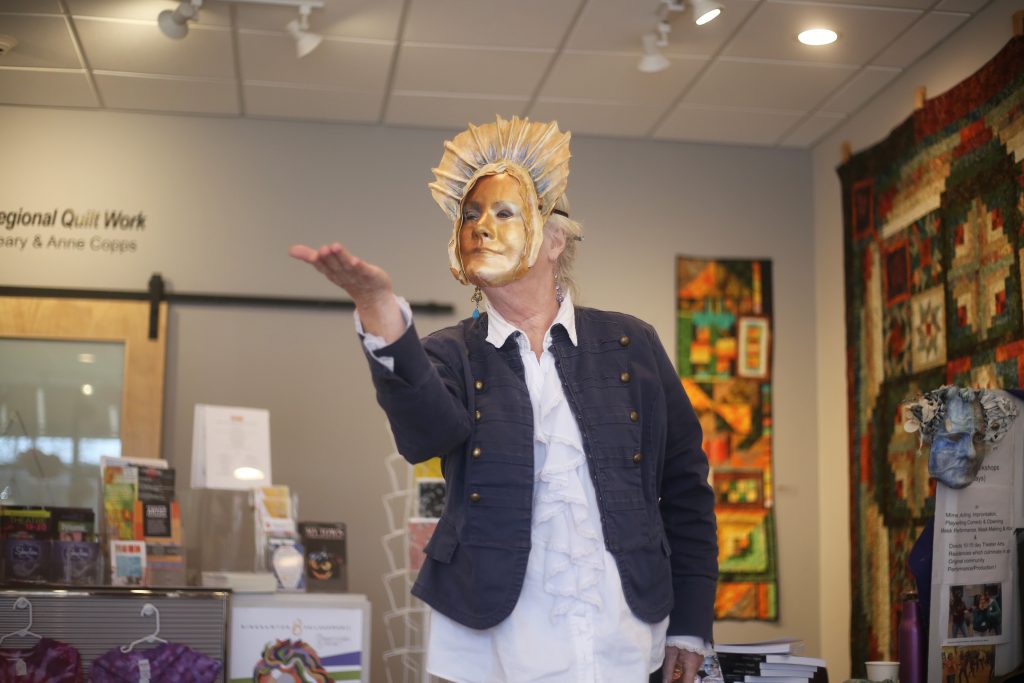Acting and theatre often involve a diverse range of skills. For local theatre artist Barbara L. Gregson, it involves mask making and mime.
On Saturday, Gregson discussed the importance of this diversity while showcasing her 2018 book, “Theater Artists Play,” at a talk hosted by the Broome County Arts Council.
“Theater Artists Play” is a guide to understanding and creating works of theatre. Gregson’s discussion mostly touched upon her life experiences and involvement in the performing arts. Attendees were greeted with hot-mulled apple cider as Gregson displayed some of her handmade masks and photos from previous workshops.
Gregson started the discussion by recalling her childhood love for putting on shows for her local community.
“I did plays starting at age 10,” she said. “I did ‘Mary Poppins,’ hired all the neighborhood kids, made them all sign contracts and of course they would all quit. I ended up playing all the parts with my sisters and we put it on for our school.”
Starting at an early age, Gregson insisted on putting on shows independently and gaining experience in all areas of theatre.
“It was all a cappella and I was standing on the stage singing, probably off-key,” she said. “We had our own costumes because my great-grandmother died and left me all these beautiful, wonderful 1800s clothes.”
Gregson said her elementary school principal was enthusiastic and supported her early endeavors in theatre.
“The respect that she had for me at age 10 was really awesome,” she said. “It made me think, ‘Okay, I can do this. Why not?’”
Gregson’s love of theatre continued through the rest of her education, leading her to study drama in London. After drama school, Gregson found work with an avant-garde theatre company in Hamburg, Germany. Because she couldn’t speak German, she mostly played mime and nonverbal part, which sparked her interest in miming. She eventually traveled to Paris to study miming with Ella Jaroszewicz.
“I love mime because it breaks all the barriers,” Gregson said. “You’re in disguise. You can be whoever you want, especially if you’re wearing a mask, and play different characters. I can be an old man, a mother, a child and you can play all the parts.”
Gregson also said miming can be a useful skill to have outside of theatre, noting that comedian Stephen Colbert has also studied it.
“Colbert does a lot of mime,” she said. “He studied acting, clowning and mime. It’s great for storytelling. Even if you’re just speaking, it’s a great skill to learn.”
Gregson’s understanding of miming helped her in her first job at a correctional facility outside Philadelphia, Pennsylvania, where she performed for inmates and worked with them to help them put on a show of their own. Gregson was hired to help improve the literacy rate among inmates and introduce them to a new art form. After performing for them, she invited them to try on her masks and sign up to be part of the show.
“One guy came up and put on the sad mask and fell down to his knees,” Gregson said. “It was a moment that affected everyone. He took the mask off and said afterward, ‘This is how this place makes me feel.’ We were able to gather an amazing group of people and put on an amazing show.”
Gregson also spent time in Italy, studying Renaissance mask making. She discussed the various types of masks with attendees and explained how each mask maker has their own unique style and techniques. According to Gregson, apprenticeships can be extremely useful for those working toward a career in the arts.
“My philosophy is that if you wanna go study with someone, you go,” she said. “I don’t believe in going to school, necessarily. I believe in apprenticing — working and studying. You learn an art form through going and doing it.”
Throughout the talk, Gregson emphasized the importance of actors and artists having multiple talents and feeling empowered to create their own jobs and become independent.
“Actors, as you may know, never get any work,” she said. “This book is about how to create your own material so you can work.”
Gregson said she values a variety of talents among the musicians and artists she works with.
“I always loved working with a musician,” she said. “That’s really important. Musicians have to be able to improvise and create new and original music. Any artist I work with has to think in that way.”



